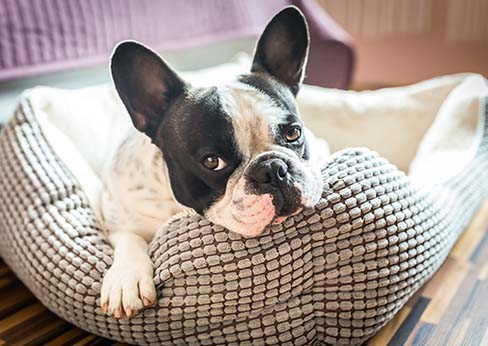Teaching your dog to go to their bed is not a skill reserved for nighttime. The command, when utilized correctly, instructs your dog to leave their current location and return to a ‘home base’ rather than simply alerting your dog that it is time to go to bed. You may want to tell your dog to ‘go to bed’ if you find yourself constantly stepping over them in the kitchen or if they are adding chaos to a crowded room. It should also be noted that a ‘bed’ does not necessarily need to be a bed – it may refer to a rug, a blanket, or any spot your dog can identify as their space. To teach your dog to go to their bed, follow the three phases below!
Phase 1: Getting Familiar with Their Bed
Start with your dog in front of their bed. If you have multiple doggie beds in your home, use the bed that you want your dog to run to when you give the “go to bed” command. Make this decision early during training and keep it consistent to avoid confusing your dog.
Throw some treats on their bed and say “BED.” The treats make the bed an attractive place for your dog, and the command creates an association with the location. Dogs do not naturally know what a bed is, so it is important that they understand what you mean when you say “BED”.
When your dog goes over to the bed, throw over some more treats and praise them for following your command. Even though your dog is just following the treats, you want them to eventually recognize that they did a good job by going to the bed when you said “BED”.
- As soon as your dog is finished eating the treats, give them the release command. The release command should be the same for all holding commands (i.e. “STAY” and “SIT”). Make sure that your dog does not leave the bed without the release – they should be waiting for you. If your dog tries to leave, use a short sound or correctional command (such as “Ah-ah”) to send your dog back to bed.
Phase 2: Lengthening the Amount of Time in Bed
As you practice more and more with the bed, your do should start hanging out in or near the bed longer waiting for treats. At this time, your dog is starting to associate their bed with treats, or positive experiences. Now, you should look to lengthen the dog’s time in their bed as they make it more of a home instead of just a treat station.
When treating your dog in their bed, look for the moments after they are done eating. They will start to look at you as if to ask, “What’s next?” Give some more treats, and when they look back at you, give the release command.
If your dog lies down in bed, throw a ton of treats onto the bed. Your dog may not even know what they did to earn so many treats, but they will begin to associate lying down in bed with a reward.
As you practice with your dog, lengthen the duration of the training sessions. Even if several rounds of treats are required, your dog will become more comfortable in that location.
Start feeding your dog on their bed. It should be noted that this is for training purposes only. Like humans, dogs like food. Eating a meal in their bed increases the amount of time they spend in bed and minimizes the notion that going to their bed is a bad thing.
Say “GO TO BED” when you see your dog go to bed naturally. Dogs do get tired, and if you can create an association between fatigue and the bed, you can add another reason why your dog would want to go to their ‘home base’.
Phase 3: Adding Distance
Now that your dog understands the purpose of their bed, they need to be comfortable staying in their bed independent of your presence.
As your dog starts to hand out on the bed longer, start adding distance. Start by walking to the other side of the room and performing personal tasks. Then, leave the room altogether. Your dog should not leave their bed without the release command.
Begin to add more distractions. Incorporate visitors or noises into your dog’s training. Other distractions may involve food – something which will certainly test your furry friend’s willpower!
Summary
The “go to bed” command can be a very useful tool when you need your dog to stay in one place and out of trouble. As always, when your dog follows the command, be sure to give them a pat on the head and praise for a job well done. Good luck!





